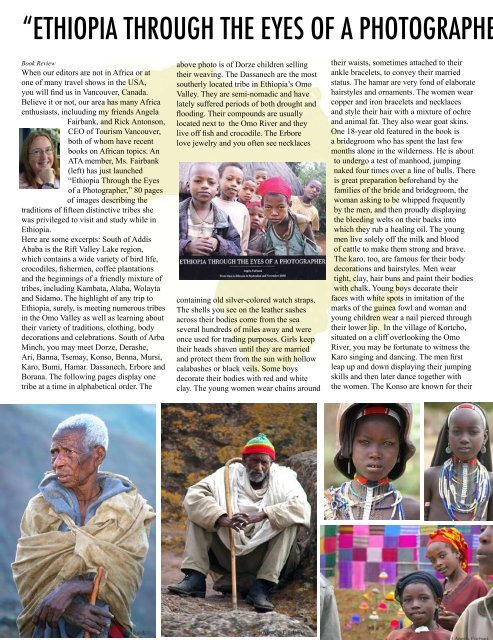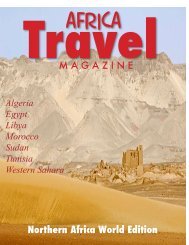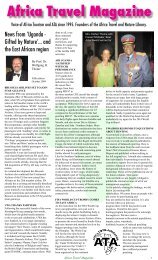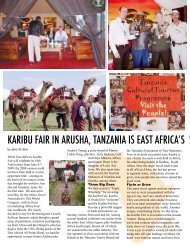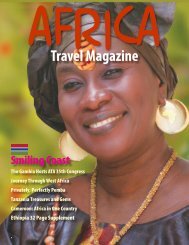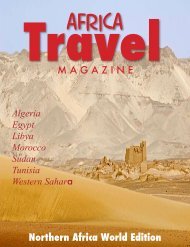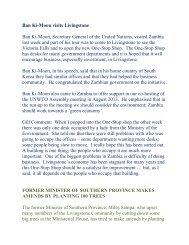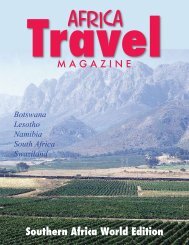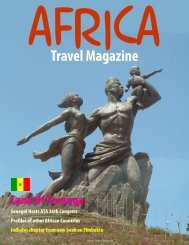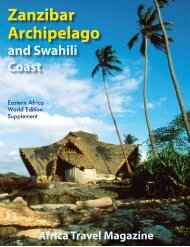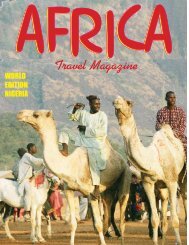ETHIOPIA MILLENNIUM EDITION - Travel Magazine
ETHIOPIA MILLENNIUM EDITION - Travel Magazine
ETHIOPIA MILLENNIUM EDITION - Travel Magazine
Create successful ePaper yourself
Turn your PDF publications into a flip-book with our unique Google optimized e-Paper software.
“<strong>ETHIOPIA</strong> THROUGH THE EYES OF A PHOTOGRAPHE<br />
Book Review<br />
When our editors are not in Africa or at<br />
one of many travel shows in the USA,<br />
you will find us in Vancouver, Canada.<br />
Believe it or not, our area has many Africa<br />
enthusiasts, incluuding my friends Angela<br />
Fairbank, and Rick Antonson,<br />
CEO of Tourism Vancouver,<br />
both of whom have recent<br />
books on African topics. An<br />
ATA member, Ms. Fairbank<br />
(left) has just launched<br />
“Ethiopia Through the Eyes<br />
of a Photographer,” 80 pages<br />
of images describing the<br />
traditions of fifteen distinctive tribes she<br />
was privileged to visit and study while in<br />
Ethiopia.<br />
Here are some excerpts: South of Addis<br />
Ababa is the Rift Valley Lake region,<br />
which contains a wide variety of bird life,<br />
crocodiles, fishermen, coffee plantations<br />
and the beginnings of a friendly mixture of<br />
tribes, including Kambata, Alaba, Wolayta<br />
and Sidamo. The highlight of any trip to<br />
Ethiopia, surely, is meeting numerous tribes<br />
in the Omo Valley as well as learning about<br />
their variety of traditions, clothing, body<br />
decorations and celebrations. South of Arba<br />
Minch, you may meet Dorze, Derashe,<br />
Ari, Banna, Tsemay, Konso, Benna, Mursi,<br />
Karo, Bumi, Hamar. Dassanech, Erbore and<br />
Borana. The following pages display one<br />
tribe at a time in alphabetical order. The<br />
above photo is of Dorze children selling<br />
their weaving. The Dassanech are the most<br />
southerly located tribe in Ethiopia’s Omo<br />
Valley. They are semi-nomadic and have<br />
lately suffered periods of both drought and<br />
flooding. Their compounds are usually<br />
located next to the Omo River and they<br />
live off fish and crocodile. The Erbore<br />
love jewelry and you often see necklaces<br />
containing old silver-colored watch straps.<br />
The shells you see on the leather sashes<br />
across their bodies come from the sea<br />
several hundreds of miles away and were<br />
once used for trading purposes. Girls keep<br />
their heads shaven until they are married<br />
and protect them from the sun with hollow<br />
calabashes or black veils. Some boys<br />
decorate their bodies with red and white<br />
clay. The young women wear chains around<br />
their waists, sometimes attached to their<br />
ankle bracelets, to convey their married<br />
status. The hamar are very fond of elaborate<br />
hairstyles and ornaments. The women wear<br />
copper and iron bracelets and necklaces<br />
and style their hair with a mixture of ochre<br />
and animal fat. They also wear goat skins.<br />
One 18-year old featured in the book is<br />
a bridegroom who has spent the last few<br />
months alone in the wilderness. He is about<br />
to undergo a test of manhood, jumping<br />
naked four times over a line of bulls. There<br />
is great preparation beforehand by the<br />
families of the bride and bridegroom, the<br />
woman asking to be whipped frequently<br />
by the men, and then proudly displaying<br />
the bleeding welts on their backs into<br />
which they rub a healing oil. The young<br />
men live solely off the milk and blood<br />
of cattle to make them strong and brave.<br />
The karo, too, are famous for their body<br />
decorations and hairstyles. Men wear<br />
tight, clay, hair buns and paint their bodies<br />
with chalk. Young boys decorate their<br />
faces with white spots in imitation of the<br />
marks of the guinea fowl and woman and<br />
young children wear a nail pierced through<br />
their lower lip. In the village of Kortcho,<br />
situated on a cliff overlooking the Omo<br />
River, you may be fortunate to witness the<br />
Karo singing and dancing. The men first<br />
leap up and down displaying their jumping<br />
skills and then later dance together with<br />
the women. The Konso are known for their


